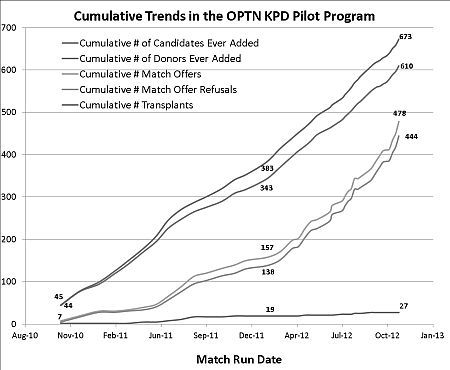Organ Procurement and Transplantation Network (OPTN) Kidney Paired Donation Pilot Program (KPDPP): Review of Current Results, The
UNOS
Yale Medical Ctr
Univ of Florida
Northwestern Univ
Carnegie Mellon Univ
Meeting: 2013 American Transplant Congress
Abstract number: 337
Background: On Oct 27, 2010, the OPTN KPDPP ran its first of 40 match runs. 128 transplant centers representing all 11 regions have joined, with 79 centers having entered at least one pair. This report highlights trends in participation, match offer refusal reasons, and the median duration from match offer to transplant from the pilot program.
Methods: Candidate and donor data were submitted from Oct 2010 – Nov 2012 by transplant centers. Matches were found using algorithms developed by Carnegie Mellon and Johns Hopkins universities.
Results: A total of 610 candidates and 673 donors (including 42 non-directed donors) have been entered. 212 (35%) candidates were matched at least once: 38 matched in at least one 2-way, 111 in 3-way, and 117 in chain exchanges. A total of 27 candidates have been transplanted. 444 of 478 match offers (93%) have been declined. 53% of the declines were not outright refusals, but rather could not have been accepted because other matches in the exchange were declined. Of the outright refusals, 36% were due to positive crossmatch or unacceptable antigens; 10% candidate/donor involved in another exchange; 10% candidate/donor too ill or unavailable; other reasons included kidney size, function, vessel issues, etc. For matches that progressed to transplant, the median time from match offer to transplant was 91 days.

Conclusion: The OPTN KPDPP continues to grow in terms of participants, matches found, and transplants. However, the majority of matches in the OPTN KPDPP are terminated before donation/transplantation. To increase the number of matches that move to transplant, the program has increased match run frequency from monthly to weekly; created a "donor pre-select" tool so centers can pre-refuse donors based on virtual crossmatch and other factors; and, since longer chains terminate more easily, decreased the maximum matches within a segment of a chain from 20 to 4. In addition, the OPTN Board of Directors voted in Nov 2012 to include bridge donors in the OPTN program.
To cite this abstract in AMA style:
Leishman R, Formica R, Andreoni K, Friedewald J, Sleeman E, Monstello C, Stewart D, Sandholm T. Organ Procurement and Transplantation Network (OPTN) Kidney Paired Donation Pilot Program (KPDPP): Review of Current Results, The [abstract]. Am J Transplant. 2013; 13 (suppl 5). https://atcmeetingabstracts.com/abstract/organ-procurement-and-transplantation-network-optn-kidney-paired-donation-pilot-program-kpdpp-review-of-current-results-the/. Accessed December 24, 2025.« Back to 2013 American Transplant Congress
